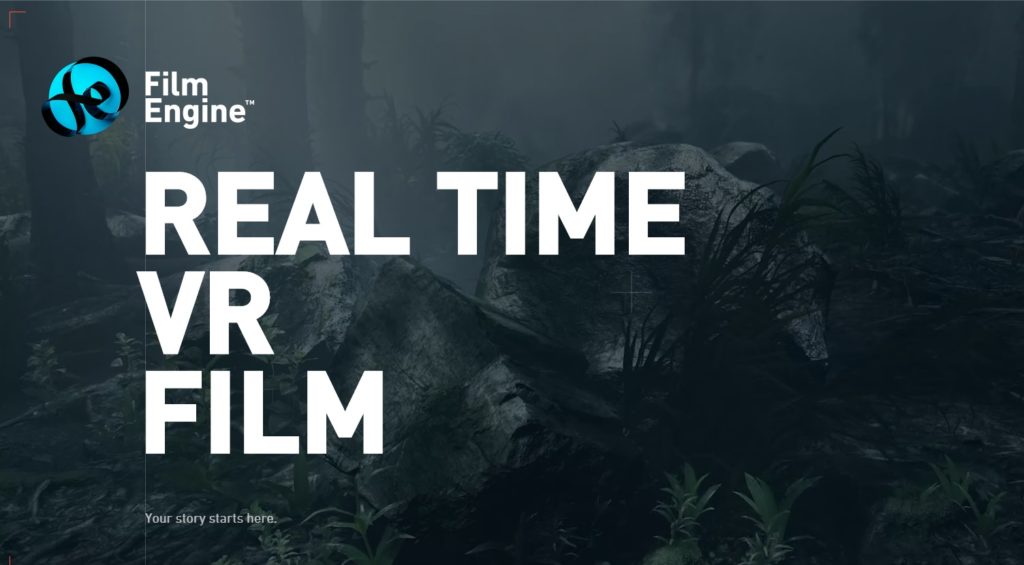Film Engine is a new company emerging with, as the name suggests, an advanced engine specifically catered to film. As we learned at Digital NewFronts, VR and fostering content creation are two of the biggest takeaways for the upcoming year.
Video game content creation suites like Unreal Engine, Unity and CryEngine have become free-to-use in recent years, creating opportunities for developers to make their otherwise unaffordable projects a reality. Following in this tradition, Film Engine is essentially an uber-version of CryEngine that allows filmmakers—student, indie and AAA—equal access to real-time VR graphics rendering.
How does it do this? “Instead of sending a project through layout, animation, lighting, rendering, grading, and editing separately, you can work on each simultaneously with real-time feedback,” reads the official website. “Tasks that once took days can be done in real-time in Film Engine, freeing up the time and the resources to focus on visionary storytelling.” Working alongside film industry professionals, Film Engine is ten years in the making.
[a]listdaily spoke with Jean-Colas Prunier, creative director of Film Engine to discuss the implications of accessibility and real-time rendering for the motion picture industry.
Aside from motion capture, how does Film Engine allow filmmakers to create in real-time?

At its core, Film Engine is designed around what we call a real-time filmmaking pipeline or workflow. It provides an integrated suite of tools that allow a user to work in parallel and in real-time on all the different areas involved in the making of a film, such as layout, animation, lighting, and editing. In addition to this real-time filmmaking pipeline, Film Engine leverages other real-time technologies, especially those used in virtual production like motion capture, camera tracking, and green screen compositing. We noticed that one of things that slows people down is the difficulty inherent in getting all of these technologies working together. We thought, “wouldn’t it be great to design Film Engine to be a hub in which all data produced by these systems can be easily recorded, combined, and used instantaneously within the same pipeline?” Until Film Engine, there was no tool on the market designed to connect them all. But it is possible to do that with Film Engine, and we put a lot of effort in making it incredibly simple to use.
The Film Engine website states, “While game engines like CryEngine can be powerful tools for cinematic work in games, they lack some of the features necessary for traditional film industry workflows.” Can you elaborate on the needs of this workflow and do you think Film Engine will inspire improvements in game engines as a result?
We don’t see CryEngine strictly as a game engine, but what we call a multi-purpose real-time engine. One of the reasons we choose CryEngine as the engine powering Film Engine is because all the features implemented in the engine are scalable. In some situations, speed is the priority; in others, quality is more important. In film, quality takes precedence, and CryEngine can deliver both. It is the perfect engine for an application like Film Engine.
Most game engines are not designed that way, which is why CryEngine is very unique compared to many of its competitors. I like to make a distinction between what I call game engines and real-time engines. What I call a real-time engine is an engine that is designed from the ground up to provide the scalability necessary for filmmakers. A real-time engine performs just as well in situations where speed is critical as it does in situations where quality is the priority, even if takes more time to render a frame.
Furthermore, the film industry needs the freedom to render assets of arbitrary complexity. The upper number of vertices or textures used for a model should be unlimited.
So we built Film Engine on top of a real-time engine that doesn’t put limitations on the complexity of the assets. Formats such as Open Subdivision surfaces, OpenEXR, Alembic, FBX, OpenColorIO, OpenVDB, and more are defacto industry standards. So we also adapted the engine in order to add the features and formats film, VFX, and animation studios expect. Film Engine follows the standards defined by www.vfxplatform.com.
Do you think there will someday be an engine that can handle both games and film without a need for two separate programs?
While making films and games have similarities, the process and the workflow in producing content for either one or the other have also a lot of differences, and the Film Engine team put a lot of effort in designing a workflow that feels natural to filmmakers. I like to see Film Engine as three layers. The first layer is the hardware layer or the GPU. The second layer is the real-time engine. The third layer is the front-end of the application or the workflow. So while I think the ideal products for making games and for making films can share the same first two layers, the same GPU and the same real-time engine, I do believe the third layer needs to be specific to each application. Here I like to use the metaphor of vehicles. While most vehicles share the same principles and the same underlying technology, each vehicle–whether a car, a four-wheel-drive vehicle, and a Formula 1 race car–has a design or “interface” that is adapted to a specific need. The same applies to software like CryEngine and Film Engine. Same principles, same underlying technology, but different interface, and that is unlikely to change in the near future.
When will Film Engine become available?
What’s important for us right now is for everyone to know that the technology is here and here to stay. We will communicate about the technology’s availability to the public and to professionals very soon. We are in early beta development phase right now, and plan to have a version 1.0 of Film Engine in the next few months. Information regarding accessibility will be communicated when we launch. In the meantime, if you are interested in the technology and want to receive updates, you can subscribe to our newsletter on our website.

